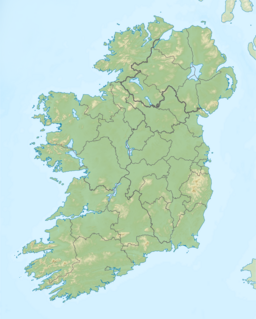Lough Derg, County Donegal
| Lough Derg | |
|---|---|
 Station Island | |
 Location in Ireland | |
| Location | County Donegal, Ireland |
| Coordinates | 54°36′50″N 7°52′20″W / 54.61389°N 7.87222°WCoordinates: 54°36′50″N 7°52′20″W / 54.61389°N 7.87222°W |
| Native name | Loch Dearg |
| Basin countries | Republic of Ireland, Northern Ireland |
| Surface area | 8.9 square kilometres (2,200 acres) |
| Islands | Station Island |
Lough Derg or Loch Derg (Irish: Loch Dearg)[1] is a lake in County Donegal, Republic of Ireland. It is near the border with Northern Ireland and lies about 7 kilometres (4.3 mi) north of the border village of Pettigo. It is best known for St Patrick's Purgatory, a site of pilgrimage on Station Island in the lake.
The lake is about 8.9 square kilometres (3.4 square miles) in size, but is quite shallow, making it dangerous during bad weather.[2] It has stocks of pike, perch and brown trout for angling.
Annual pilgrimage[]

The traditional three-day pilgrimage follows a one-thousand-year-old pattern. It begins on any day between 1 June and 13 August and lasts three days during which participants may only have one Lough Derg meal each day (black tea/coffee, dry toast, oat cakes, water). On arrival on the island, participants remove footwear and socks before commencing vocal prayers, walking around the island. A 24-hour night vigil then takes place on the first night. Generally, pilgrims depart on the morning of the third day having slept on their second night. They complete their pilgrimage fast at midnight the day of departure.[3] The pilgrimage is suitable for persons over 15 years. Pilgrims must be able to walk and kneel unaided and be physically able to undertake the fast.[4]
Islands[]

Including Station Island, there are about 30 islands and islets in Lough Derg, including:[5]
- Allingham's Island
- Ash Island
- Boat Island
- Bull's Island
- Derg Beg Island
- Derg More Island
- Friar's Island
- Goose Lodge
- Gravelands Islands
- Illan Philipboy
- Inishgoosk
- Kelly's Isles
- Long Island
- Saints Island (on which there is a graveyard and the buried ruins of a monastery)
- Trough Island
Folklore[]
According to folklore a man named Conan once threw a worm into the lake. The worm then grew into a large monster called Caoránach that devoured the local cattle. Once a majority of the cattle in Ulster died the locals blamed Conan who then enraged attacked the beast, killing it. Its blood dyed the rocks red and this is where the name Lough Derg comes from.[6]
See also[]
- List of loughs in Ireland
References[]
| Wikimedia Commons has media related to Lough Derg, County Donegal. |
- ^ Placenames Database of Ireland
- ^ National Regional Fisheries Board Archived 2007-11-19 at the Wayback Machine
- ^ "Official website" (PDF). Archived from the original (PDF) on 14 June 2015. Retrieved 13 June 2015.
- ^ https://www.loughderg.org/what-you-need-to-know-as-you-plan-your-pilgrimage/
- ^ Ordnance Survey Ireland: Map Viewer
- ^ Richardson, John (1727). textsThe great folly, superstition, and idolatry, of pilgrimages in Ireland; especially of that to St. Patrick's purgatory. Together with an account of the loss that the publick sustaineth thereby; truly and impartially represented. pp. 2–3.
- Lakes of County Donegal
- County Donegal geography stubs
